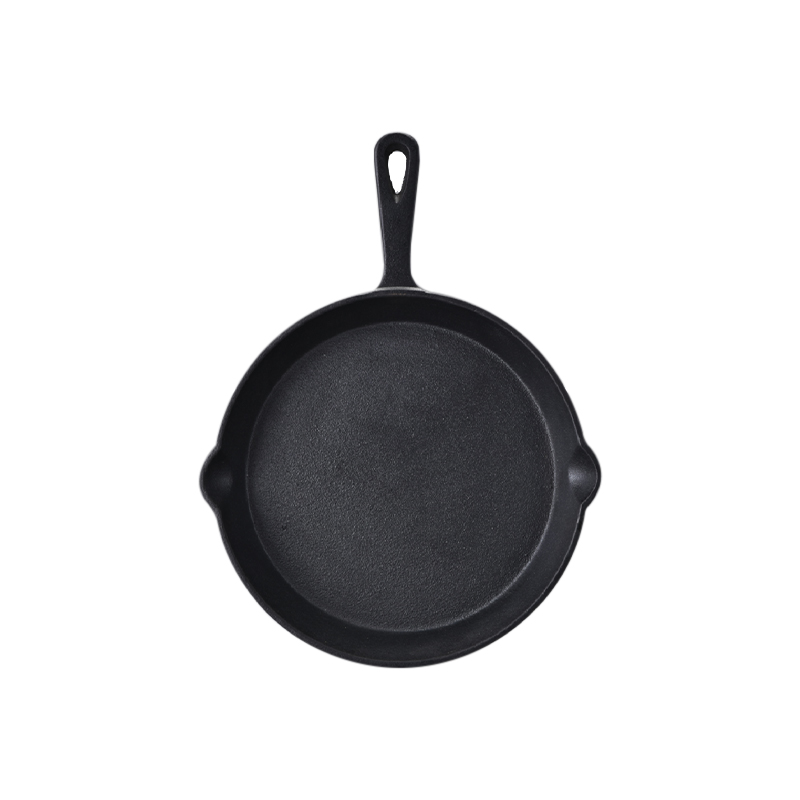When choosing a cast-iron frying pan with a lid, the decision between seasoned and enameled varieties often comes down to your cooking habits, maintenance preferences, and the dishes you love to make. Both types leverage cast iron’s excellent heat retention and stovetop-to-oven versatility, but they differ in surface care, ingredient compatibility, and long-term use. This guide breaks down their key characteristics to help you find the right fit for your kitchen.

Side-by-Side: Core Differences
Comparing the fundamental traits of seasoned and enameled cast iron reveals how each performs in daily use.
Surface Care Requirements
Seasoned cast iron relies on a naturally developed layer of polymerized oil, built up through repeated cooking and oiling. This layer improves over time, creating a smooth, protective surface. Enameled cast iron, by contrast, features a pre-applied glass coating that eliminates the need for seasoning—it’s rust-resistant right out of the box, with no extra steps to maintain its surface.
Compatibility with Ingredients
Enameled surfaces are non-reactive, making them ideal for cooking acidic foods like tomatoes, vinegar-based sauces, or citrus-marinated dishes for extended periods. The enamel acts as a barrier, preventing the iron from interacting with acids. Seasoned cast iron, however, can react with prolonged exposure to acidity, which may dull the seasoning or impart a subtle metallic note to food—best reserved for non-acidic recipes unless the seasoning is well-established.
Daily Maintenance Routine
Cleaning seasoned cast iron typically involves wiping with hot water and a stiff brush or scraper while the pan is still warm. Mild soap can be used sparingly for tough stains, but excessive soap may strip the seasoning. After drying, a thin layer of oil is applied to keep the surface protected. Enameled cast iron simplifies cleanup: it can be washed with regular dish soap and a soft sponge, and there’s no need for post-cleaning oiling.
Weight and Handling
Both types are sturdy and substantial, a hallmark of cast iron’s durability. Enameled pans may feel slightly heavier due to the added coating, but the difference is often minimal. Both feature similar handle designs, though some enameled models may have heat-resistant handles that make oven-to-table serving more convenient.
The Appeal of Seasoned Cast Iron
Seasoned cast iron is the traditional choice, valued for its evolving performance and resilience.
A Surface That Improves Over Time
The more you use a seasoned pan, the better it gets. Each cooking session adds to the seasoning layer, creating a natural non-stick surface that rivals synthetic coatings. This patina also enhances flavor, adding subtle depth to dishes like fried eggs, seared meats, and cornbread.
Durability and Restorability
Seasoned cast iron stands up well to metal utensils—scratches are less of a concern, as they can be repaired through re-seasoning. If rust develops (usually from moisture left on the surface), it can be removed with a wire brush and mild soap, followed by re-seasoning to restore the pan to its original condition. This longevity means a well-cared-for seasoned pan can last for generations.
Key Considerations
It requires a consistent care routine: never leave water sitting in the pan, dry it thoroughly after cleaning, and oil it regularly. Storing food in a seasoned pan for long periods is not recommended, as this can damage the seasoning or lead to rust.
The Advantages of Enameled Cast Iron
Enameled cast iron offers convenience and versatility with less hands-on maintenance.
Ready-to-Use Convenience
There’s no breaking-in period—enameled pans are ready to cook with the first use. This makes them a great option for those who prefer a “take-it-out-and-cook” experience without the learning curve of seasoning.
Aesthetic and Practical Design
Enameled cast iron comes in a wide range of colors, from classic neutrals to vibrant hues, making it a stylish addition to both the stovetop and the dinner table. Many models are designed for oven-to-table serving, eliminating the need for extra dishes.
Key Considerations
The enamel coating, while durable, can chip if the pan is dropped or struck against hard surfaces. To preserve the interior, it’s best to use wooden, silicone, or nylon utensils instead of metal. Chipped enamel doesn’t render the pan unusable, but it may expose the iron underneath, so avoiding acidic foods in chipped pans is advisable.
Shared Strengths
Both seasoned and enameled cast iron excel at heat retention, ensuring even cooking for everything from searing to simmering to baking. They’re both oven-safe, making them versatile for one-pan meals. Ultimately, the choice hinges on how much maintenance you’re willing to commit to—and the dishes that make your kitchen feel like home.



